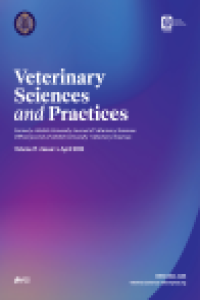Diyabetik ve Non-Diyabetik Farelerin Midesinin Fundus Bölgesinde Hepatosit Büyüme Faktörü (HGF)’nün İmmunohistokimyasal Lokalizasyonu
Diyabet, Fundus, HGF, immunohistokimya
Immunohistochemical Localization of Hepatocyte Growth Factor (HGF) in the Fundus Area of the Stomach of Diabetic and Non-Diabetic Mice
Diabetes , Fundus, HGF, Immunohistochemistry,
___
- 1. Catchpole B., Ristic JM., Fleeman LM., Davison LJ., 2005. Canine Diabetes Mellitus: can old dogs teach us new tricks?. Diabetologia, 48, 1948-1956.
- 2. Börset M., Hansen HH., Seidel C., Sundan A., Waage A., 1996. Hepatocyte growth factor and its receptor c-met in multiple myeloma. Blood, 88, 3998-4004.
- 3. Birchmeier A., Birchmeier W., Gherardi E., Vande Woude GF., 2003. Met, metastasis, motility and more. Nat Rev Mol Cell Biol, 4, 915-925.
- 4. You WK., McDonald DM., 2008. The hepatocyte growth factor/c-Met signaling pathway as a therapeutic target to inhibit angiogenesis. BMB Rep, 41, 833-839.
- 5. Dai C., Li Y., Yang J., Liu Y., 2003. Hepatocyte growth factor preserves beta cells mass and mitigates hyperglycemia in streptozotocin induced diabetic mice. J Biol Chem, 278, 27080-27087.
- 6. Rand JS., Fleeman LM., Farrow HA., Appleton DJ., Lederer R., 2004. Canine and feline diabetes mellitus nature or nuture. J Nutr, 134, 2072-2080.
- 7. Reusch CE., Tschour F., Kley S., Boretti S., Sieber-Ruckstuhl N., 2006. Diabetes mellitus in the cat: A Review. Schweiz Arch Tierheilkd, 148, 130-138.
- 8. Tang YL., Dong XY., Zeng ZG., Feng Z., 2020. Gene expression-based analysis identified NTNG1 and HGF as biomarkers for diabetic kidney disease. Medicine (Baltimore), 99, e18596.
- 9. Kastelan S., Oreskovic I., Biscan F., Kastelan H., Gverovic Antunica A., 2020. Inflammatory and angiogenic biomarkers in diabetic retinopathy. Biochem Med, 30, 385-399.
- 10. Fujita Y., Murakami T., Nakamura A., 2021. Recent advances in biomarkers and regenerative medicine for diabetic neuropathy. Int J Mol Sci, 22, 2301.
- 11. Oliveira AG., Araujo TG., Carvalho BM., Rocha GZ., Santos A., Saad MJA., 2018. The role of hepatocyte growth factor (HGF) in insulin resistance and diabetes. Front Endocrinol (Lausanne), 30, 503.
- 12. Kanitkar M., Bhonde R., 2004. Existence of islet regenerating factors within the pancreas. Rev Diabet Stud, 1, 185-192.
- 13. Luna LD., 1968. Manuel of Histologic Staining Methods of the Armed Forces Institute of Pathology. 3rd ed., 38-39, McGraw-Hill Book Company, New York.
- 14. Hsu SM., Raine L., Fanger H., 1981. Use of avidin- biotin- peroxidase cpmplex (ABC) in immunoperoxidase techniques: a comparison between ABC and unlabeled antibody (PAP) procedures. J Histochem Cytochem, 29, 577-580.
- 15. Shu S., Ju G., Fan L., 1988. The glucose oxidase-dan-nickel in peroxidase histochemistry of the nervous system. Neuroscience Lett, 85, 169-171.
- 16. Jelodar G., Mohammadi M., Akbari A., Nazifi S., 2020. Cyclohexane extract of walnut leaves improves indices of oxidative stress, total homocysteine and lipids profiles in streptozotocin‐induced diabetic rats. Physiol Rep, 8, e14348.
- 17. Bastaki SMA., Adeghate E., Chandranath IS., Amir N., Tariq S., Hameed RS., Adem A., 2010. Effects of streptozotocin-induced long-term diabetes on parietal cell function and morphology in rats. Mol Cell Biochem, 341, 43-50.
- 18. O’Reilly D., Long RG., 1987. Diabetes and the gastrointestinal tract. Dig Dis Sci, 5, 57-64.
- 19. Takehara K., Tashima K., Takeuchi K., 1997. Alterations in duodenal bicarbonate secretion and mucosal susceptibility to acid in diabetic rats. Gastroenterology, 112, 418-428.
- 20. Lin CY., Yeh GH., Hsu FC., Tsai SC., Lau CP., Pu HF., Yu HL., Tung YF., Wang PS., 1991. Gastric acid secretion in streptozotocin-diabetic female rats. Clin J Physiol, 34, 179-186.
- 21. Baydoun R., Dunbar JC., 1997. Impaired insulin but normal pentagastrin effect on gastric acid secretion in diabetic rats: a role for nitric oxide. Diabetes Res Clin Pract, 38, 1-8.
- 22. Feldman M., Schiller LR., 1983. Disorders of gastrointestinal motility associated with diabetes mellitus. Ann Intern Med, 98, 378-384.
- 23. Weber JR., Ryan JC., 1998. Effects on the gut of systemic disease and other extraintestinal conditions. In: Scharschmidt BF, Slei-singer MH, Feldman M (eds) Gastrointestinal and liver disease. WB Saunders Co, Philadelphia, pp: 413-416.
- 24. Grant DS., Kleinman HK., Goldberg ID., Bhargava MM., Nickoloff BJ., Kinsella JL., Polverini P., Rosen EM., 1993. Scatter factor induces blood vessel formation in vivo. Proc Natl Acad Sci, 90, 1937-1941.
- 25. Ono K., Matsumori A., Shioi T., Furukawa Y., Sasayama S., 1997. Enhanced expression of hepatocyte growth factor/c-Met by myocardial ischemia and reperfusion in a rat model. Am Heart Ass, 95, 2552-2558.
- 26. Mizuno S., Nakamura T., 2005. Prevention of neutrophil extravasation by hepatocyte growth factor leads to attenuations of tubular apoptosis and renal dysfunction in mouse ischemic kidneys. Am J Pathol, 166, 1895-1905
- Başlangıç: 2022
- Yayıncı: Atatürk Üniversitesi
Serdal KURT, Funda EŞKİ, Pınar AYVAZOĞLU DEMİR
Laboratuvar Hayvalarında Oluşturulan Deneysel İnflamasyon Modelleri
Rastgele Seçilen IV Serum Setlerinin Sabit Oranlı İnfüzyona Etkileri: In-Vitro Gösterim
Mümin Gökhan ŞENOCAK, Latif Emrah YANMAZ, Ugur ERSOZ, Sıtkıcan OKUR, Ferda TURGUT
Güney Karaman Koyununda Sinus İnterdigitalis Üzerine Morfolojik Bir Çalışma
Zekeriya ÖZÜDOĞRU, Derviş ÖZDEMİR
Serap İLHAN AKSU, Turgay DEPREM
Sıçanlarda 5-Florourasil ile İndüklenen Nefrotoksisitede Rutin’in Etkileri
Rutin Ratlarda Metotreksata Bağlı Hepatik Oksidatif Stresi Hafifletir
Sueda TÜRK, Filiz KAZAK, Pinar PEKER, Mehmet Ali KISAÇAM
Mustafa KOÇKAYA, Mehmet EKİCİ, Engin GENÇ, Serkan ÇELİKGÜN, Hacer BAŞ EKİCİ
Köpeklerin Kronik Endometritislerinde Sydecan- 1(CD138)’in Diagnostik Önemi
Serkan YILDIRIM, Fatma İLHAN, Muhammet Bahaeddin DÖRTBUDAK, Nebi ÇETİN
